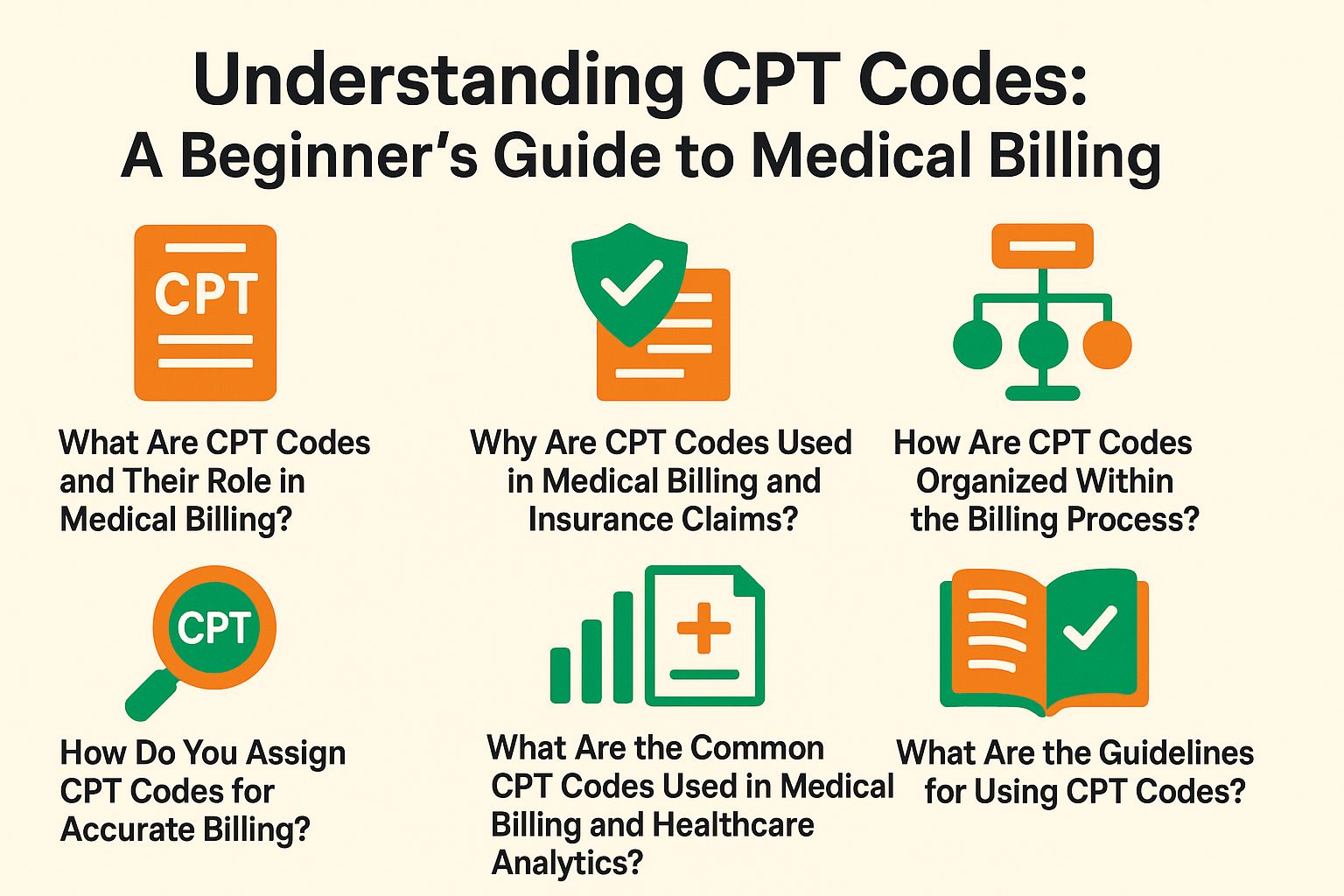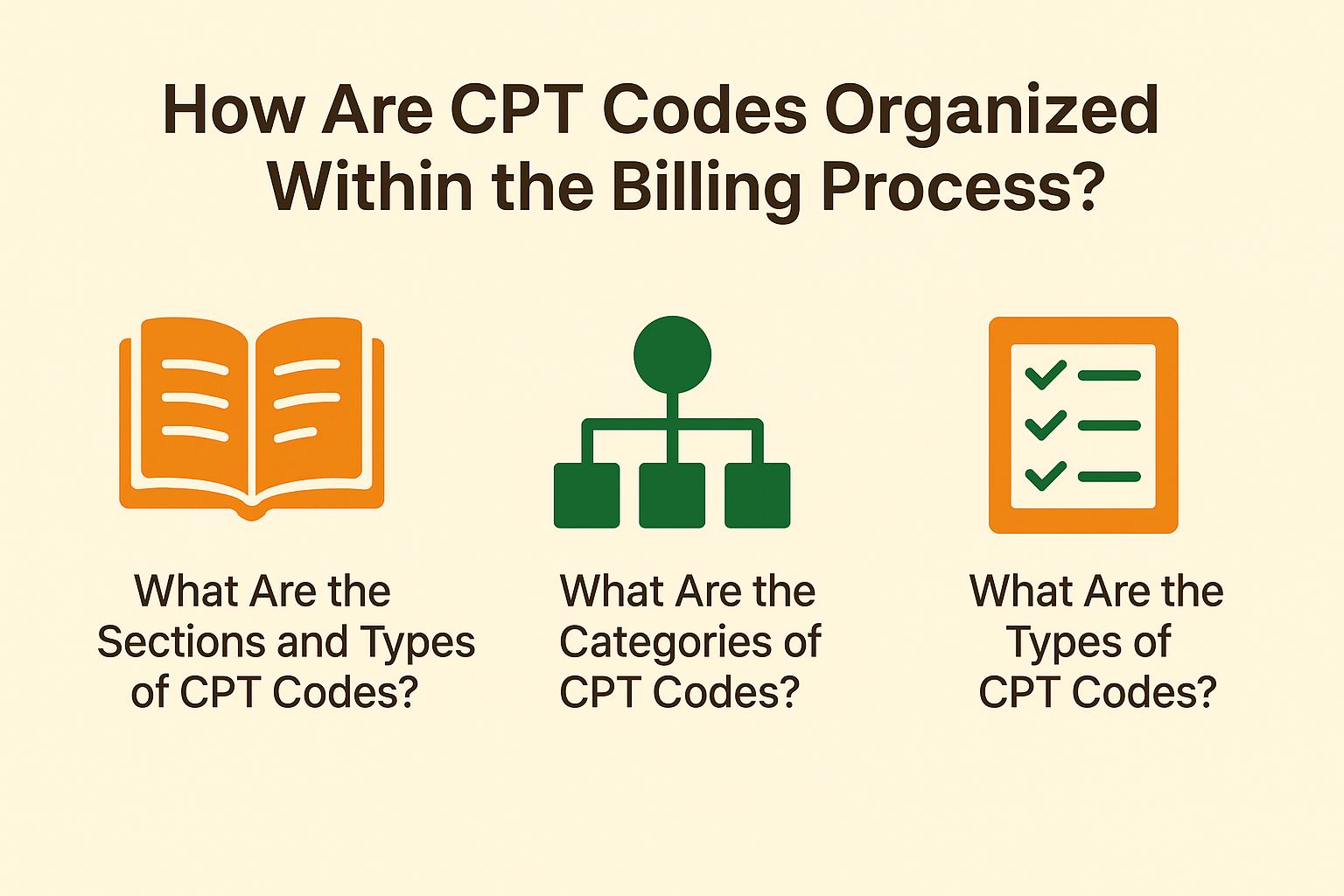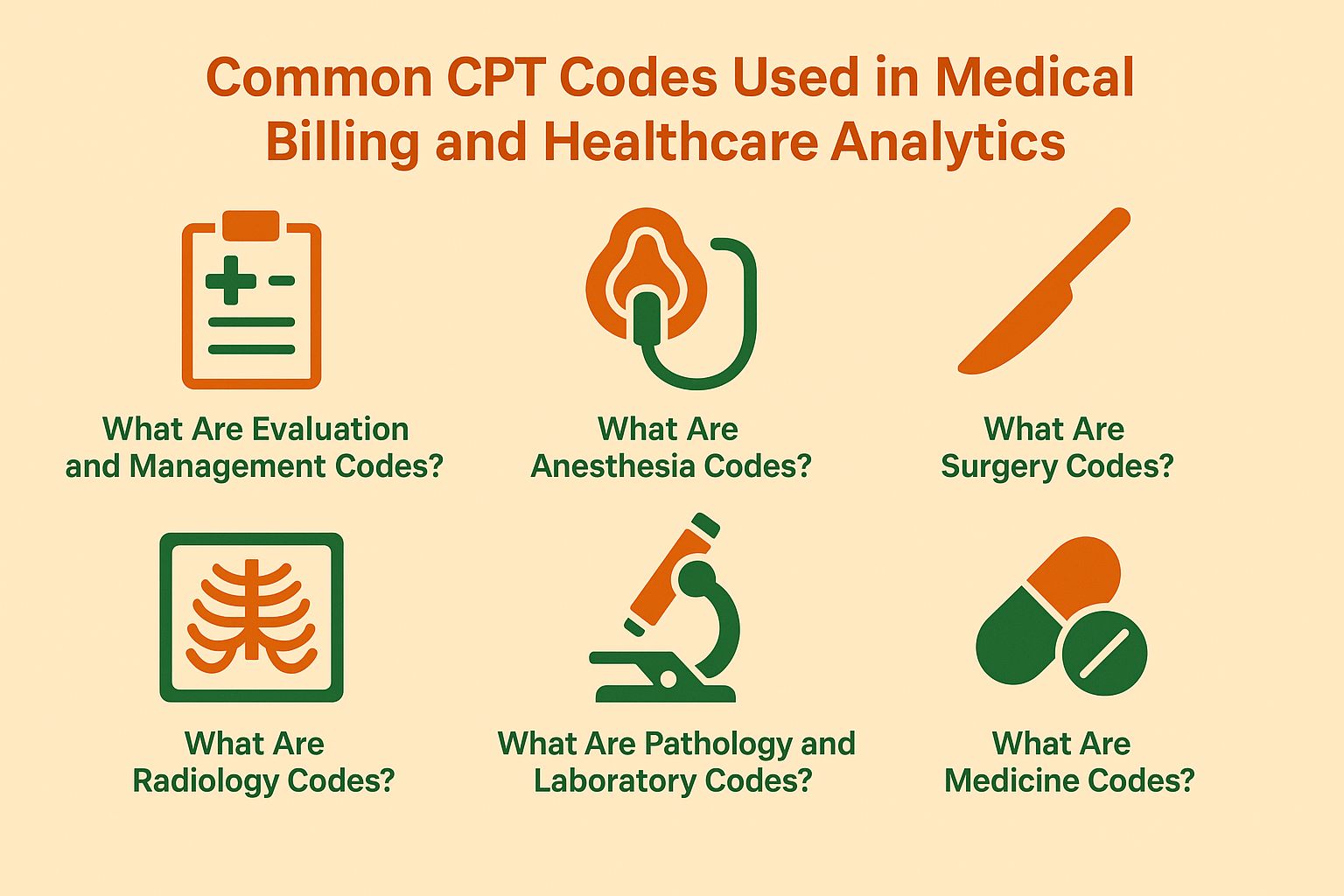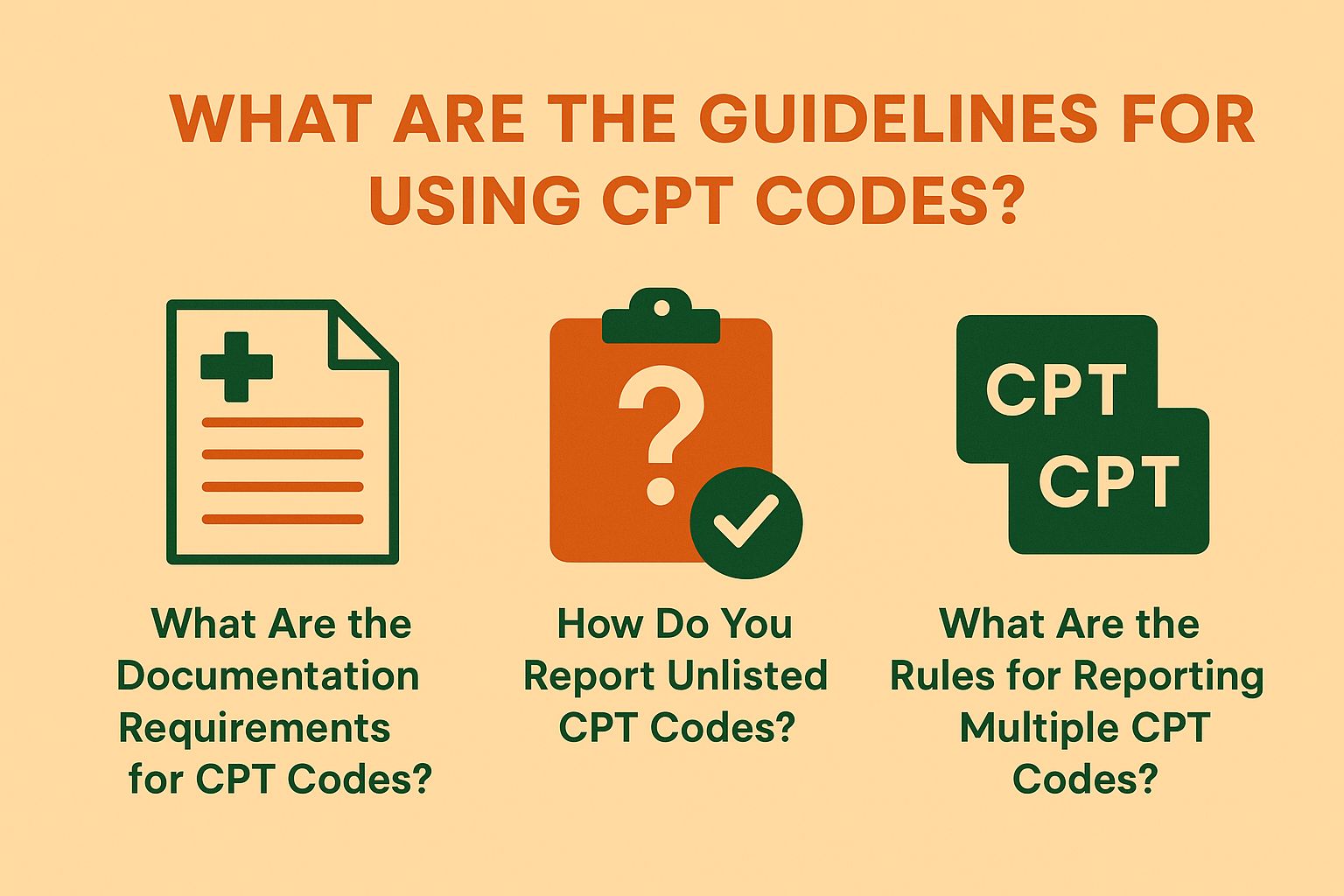
Understanding CPT Codes: A Beginner’s Guide to Medical Billing
CPT codes, or Current Procedural Terminology codes, are essential tools in the medical billing process, serving as the universal language for describing medical, surgical, and diagnostic services. This guide will break down the purpose and organization of CPT codes, explain how to assign them correctly, and explore the common categories used in medical billing. Whether you are a healthcare professional, a student, or simply someone interested in understanding medical billing, this guide will illuminate the intricacies of CPT codes and their crucial role in the healthcare system.
What Are CPT Codes and Their Role in Medical Billing?
CPT codes, or Current Procedural Terminology codes, are a standardized set of procedure codes utilized in healthcare to represent medical, surgical, and diagnostic services and procedures performed by healthcare professionals, thereby supporting effective medical billing.
These codes play a critical role in the healthcare billing process, serving as the means of communication between healthcare providers and insurance companies regarding the services delivered to patients, ensuring healthcare compliance and reimbursement accuracy.
It is essential for you to understand CPT codes for accurate medical billing, as they are instrumental in determining reimbursement amounts and ensuring compliance with healthcare regulations.
Why Are CPT Codes Used in Medical Billing and Insurance Claims?
CPT codes are essential in medical billing as they standardize the reporting of healthcare services and procedures for insurance claims processing. This standardization ensures that healthcare providers receive appropriate reimbursement for the services they deliver, facilitating effective claim submission.
By utilizing these codes, healthcare professionals can communicate effectively with insurance companies, which facilitates smoother claims submission and minimizes billing discrepancies.
Additionally, CPT coding helps maintain compliance with billing regulations and supports healthcare finance by accurately reflecting the services rendered.
How Are CPT Codes Organized Within the Billing Process?
CPT codes are organized into a structured system that categorizes them into various sections based on the type of healthcare services they represent. This organization supports healthcare providers in achieving easier coding and documentation, enabling a systematic approach to billing and coding accuracy.
The CPT coding system consists of three categories, which are integral to coding guidelines:
- Category I, which encompasses the most commonly used codes for clinical procedures, such as 99213 for an established patient office visit, crucial for medical coding and billing practices;
- Category I, which encompasses the most commonly used codes for clinical procedures and is pivotal for coding accuracy;
- Category I, which encompasses most medical services;
- Category II, focusing on performance measures;
- Category III, which includes temporary codes for emerging technologies and procedures.

What Are the Sections and Types of CPT Codes?
The sections of CPT codes are organized into specific categories, each designed to classify various types of healthcare services, including evaluation and management, anesthesia, surgery, radiology, pathology and laboratory, and medicine.
Each section contains distinct codes that correspond to specific medical procedures, facilitating accurate documentation and billing for services rendered by healthcare providers.
These classifications are essential in streamlining healthcare practices by ensuring compliance with coding guidelines. For example, the Evaluation and Management section includes codes for office visits, consultations, and preventive health services, which support proper assessment and care.
The Anesthesia section specifies codes associated with different types of surgical procedures, helping with the billing for anesthesia services provided during various operations. Likewise, the Surgery section encompasses a wide array of codes for both outpatient and inpatient surgical interventions.
Other categories, such as Radiology, Pathology and Laboratory, and Medicine, contain codes corresponding to diagnostic procedures, laboratory tests, and treatment interventions. This comprehensive framework enables healthcare professionals to effectively manage and report their specialty services.
What Are the Categories of CPT Codes?
CPT codes are classified into three main categories: Category I codes, which represent the majority of procedural services performed by healthcare providers; Category II codes, which are supplemental tracking codes used for performance measurements; and Category III codes, which are temporary codes for emerging technologies, services, and procedures. Each category plays a specific role in the medical billing and coding process, contributing to coding accuracy and effective reimbursement.
For example, Category I codes encompass a wide range of services, from evaluation and management to surgical procedures, typically including five-digit numeric codes such as 99213 for an established patient office visit. In contrast, Category II codes, like 0001F for smoking cessation counseling, provide additional data for quality reporting but do not directly impact reimbursement.
Category III codes, which may include codes for innovative procedures like 0345T for transcatheter ablation of atrial fibrillation, reflect the latest advancements in medical technology. By understanding the nuances of each CPT category, healthcare professionals can enhance accuracy during the billing process and ensure they are properly reimbursed for the services provided.
What Are the Types of CPT Codes?
There are several types of CPT codes that primarily focus on specific medical procedures, including codes for surgeries, diagnostic tests, and evaluation and management services. Each type of code is essential for accurately capturing the services provided during patient encounters, which in turn ensures proper billing and reimbursement processes in healthcare.
The American Medical Association (AMA) classifies these codes into three categories:
- Category I, which encompasses the most commonly used codes for clinical procedures, such as 99213 for an established patient office visit.
- Category II, intended for performance measurement codes that assist healthcare providers in tracking the quality of care delivered.
- Category III, which includes temporary codes for emerging technologies and procedures that may not yet have a permanent CPT code assigned, such as codes for new surgical techniques.
Understanding these distinctions is critical for achieving accuracy in medical billing and coding. Healthcare practices rely on comprehensive billing software and coding resources to ensure they receive appropriate reimbursements for the services they provide.
How Do You Assign CPT Codes for Accurate Billing?
Assigning CPT codes necessitates a comprehensive understanding of coding guidelines and a systematic approach to code assignment based on the services rendered during healthcare encounters, ensuring compliance with billing cycles and reimbursement rates.
It is essential for healthcare professionals to ensure the correct codes are assigned to accurately represent the medical necessity of the services provided. This accuracy facilitates appropriate reimbursement and compliance with billing procedures.
Additionally, this process involves reviewing patient records and documentation to confirm that the assigned codes align accurately with the services billed.
What Are the Key Components of CPT Codes and Billing Software?
The key components of CPT codes include the code number, descriptors, and modifiers, which together provide detailed information about the services rendered. Each CPT code consists of a specific five-digit number that uniquely identifies the procedure, accompanied by a descriptive term that explains the service. Modifiers indicate any additional information or variations in the procedure performed.
Understanding these components is essential for accurate medical coding, as they directly influence healthcare costs and reimbursement rates. The codes serve as a universal language among healthcare providers, insurers, and billing software systems, ensuring that the documentation accurately reflects the services provided.
For instance, the code number streamlines the billing process, while the descriptors enhance clarity and eliminate ambiguities. Modifiers adjust the initial codes to capture any special circumstances or complications, ensuring the financial aspects accurately reflect the patient’s treatment journey.
Together, these elements facilitate effective communication within the healthcare system and play a critical role in maintaining compliance and optimizing revenue cycles.
How Do You Determine the Correct CPT Code for Claim Processing?
Determining the correct CPT code requires a careful analysis of healthcare documentation and matching the services provided with the appropriate codes from the CPT coding system. This process necessitates that you, as a healthcare professional, possess a comprehensive understanding of coding standards and regulations to avoid errors that could result in claim denials or underpayment.
It is essential for you to utilize reliable coding resources and guidelines while ensuring that all relevant details are documented accurately. This meticulous approach not only streamlines claims processing but also minimizes billing discrepancies that could arise from inadequate or incorrect information.
You must also stay informed about the nuances of various insurance policies to effectively navigate the complexities of reimbursement and coding. Consequently, maintaining accurate documentation becomes a vital best practice, enabling you to secure appropriate compensation while adhering to industry regulations.
What Are the Common CPT Codes Used in Medical Billing and Healthcare Analytics?
Common CPT codes used in medical billing encompass a broad spectrum of medical services, including evaluation and management, anesthesia, surgery, radiology, pathology and laboratory, as well as various medicine services.
Familiarity with these codes is crucial for healthcare providers to ensure accurate billing and effective claims processing, ultimately maximizing reimbursement from insurance companies.

What Are Evaluation and Management Codes?
Evaluation and management (E/M) codes represent a specific subset of CPT codes that detail various services rendered by healthcare professionals, primarily focusing on patient assessment, diagnosis, and care planning. These services can include both outpatient services and inpatient services.
These codes are fundamental in medical billing, as they establish reimbursement levels based on the complexity and duration of patient encounters.
Understanding the intricacies of these codes is crucial for ensuring accurate healthcare documentation, adherence to coding guidelines, and avoiding common coding challenges.
For example, selecting the appropriate E/M code can have a significant impact on a practice’s revenue cycle management, given that these codes are directly linked to the services provided.
Common scenarios include office visits where a physician assesses a patient’s condition, formulates a treatment plan, or manages chronic illnesses. Accuracy in choosing E/M codes not only guarantees appropriate reimbursement but also serves as a reflection of the quality of care delivered, which is essential for effective practice management within the healthcare system.
What Are Anesthesia Codes?
Anesthesia codes represent specific services delivered by anesthesiologists and qualified healthcare providers during surgical procedures, capturing the intricacies of anesthesia management and ensuring proper insurance reimbursement.
These codes are vital for accurate billing for anesthesia services and ensuring that healthcare providers receive appropriate reimbursement for their work in a surgical environment.
Accurate coding not only streamlines transactions between healthcare providers and insurers but also plays a critical role in maintaining the financial stability of medical practices, enhancing revenue generation.
In the rapidly changing landscape of healthcare, where coding errors can result in claim denials and delayed payments, understanding the intricacies of anesthesia codes is essential.
These codes ensure that every procedure, from routine surgeries to complex interventions, is documented properly, which in turn influences insurance reimbursement rates. Precise coding enhances the overall quality of care and reflects the level of expertise required in anesthesia management, thereby reinforcing the value practitioners bring during significant surgical events.
What Are Surgery Codes?
Surgery codes play a vital role in the CPT coding system, representing a variety of surgical procedures performed by healthcare professionals and ensuring proper documentation in medical records.
These codes are essential for accurate medical billing, as they directly influence the reimbursement process and must be assigned correctly to reflect the specific procedures carried out during a patient encounter.
For example, the codes ranging from 10021 to 69990 encompass everything from minor surgical interventions, such as skin biopsies, to more complex operations, like heart surgeries. This range demonstrates the diversity within the CPT coding structure.
Utilizing these codes aids in standardizing procedures across the healthcare industry, ensuring that healthcare documentation remains precise and compliant with regulatory standards.
It is important to note that codes can vary by specialty; for instance, orthopedic surgery codes typically include arthroscopy and joint replacement procedures. Compliance audits often focus on these critical codes to verify alignment with the documented services provided, which helps in minimizing billing discrepancies.
What Are Radiology Codes?
Radiology codes encompass a wide range of imaging services, including X-rays, MRIs, and CT scans, and they establish a framework for billing these medical procedures, reflecting the extensive coding systems used in healthcare.
Accurately assigning radiology codes is essential for ensuring precise reimbursement and compliance with healthcare regulations.
These codes play a pivotal role in the medical coding process, as they dictate how healthcare providers document and submit claims for imaging services, ensuring compliance with payer requirements.
Proper coding not only conveys the specifics of each procedure to payers but also supports the integrity of healthcare documentation, which ultimately affects coding accuracy.
When codes are meticulously assigned, it enhances your facility’s ability to receive timely and appropriate payments for services rendered. Having a thorough knowledge of radiology codes is crucial for healthcare professionals to effectively navigate the complexities of claims submission and to avoid potential denials that may arise from misinterpretation or errors in the coding process.
What Are Pathology and Laboratory Codes?
Pathology and laboratory codes are essential for identifying a variety of diagnostic tests, diagnostic codes, and services conducted in laboratory environments, enabling accurate billing for these critical healthcare services.
It is important for healthcare providers to understand these codes to ensure proper reimbursement and effective management of laboratory-related claims.
These codes not only enhance the billing process but also play a significant role in the comprehensive documentation and reporting of medical services provided to patients. For example, the CPT code 88305, which relates to surgical pathology examinations, illustrates how specific codes delineate the various procedures performed in laboratories.
Accurate coding reduces the risk of coding audits and helps prevent claim denials, ultimately improving revenue cycle management. Familiarity with common codes, such as 80050 for general health panels, underscores the importance of precise coding to ensure that healthcare providers are fairly reimbursed for the services they deliver.
What Are Medicine Codes?
Medicine codes encompass a range of non-surgical healthcare services, including immunizations, psychotherapy, telehealth billing, and various outpatient services provided by healthcare professionals.
These codes are vital for accurate medical billing and reimbursement, reflecting the diverse array of services available in the healthcare industry.
They act as a crucial link between healthcare providers and insurance companies, ensuring that the services rendered are properly documented and reimbursed, which is essential for effective healthcare administration.
For instance, when a patient receives a vaccination, the appropriate code streamlines the billing process, minimizing the potential for denials and ensuring compliance with established coding standards.
Accurate medicine coding has a significant impact on revenue cycles; errors in coding can lead to compliance audits, delayed payments, and even potential legal issues, which underscores the importance of coding compliance.
Therefore, it is essential for healthcare professionals to stay informed about the latest coding guidelines.
This knowledge enhances their efficiency in delivering seamless care while effectively navigating the complex landscape of medical reimbursement and adhering to medical billing ethics.
What Are the Guidelines for Using CPT Codes?
The guidelines for using CPT codes are established to ensure consistency, accuracy, and compliance in the coding and billing processes within the healthcare industry, including the proper use of CPT code lookup tools.
Adhering to these guidelines is essential for healthcare providers to maintain coding accuracy and avoid billing discrepancies, which can result in claim denials and reimbursement challenges.
These guidelines also cover documentation requirements, modifiers, and other regulations that influence the correct application of CPT codes.

What Are the Documentation Requirements for CPT Codes?
Documentation requirements for CPT codes are essential in ensuring that the services billed correspond with the procedures performed and meet the standards of medical necessity. Accurate and thorough documentation assists you in supporting your coding decisions, facilitating successful claims submission, and minimizing the risk of claim denials due to insufficient information.
Maintaining comprehensive patient records is crucial for enhancing coding accuracy. This entails documenting the specifics of each patient visit, including diagnoses and any treatments provided, while also adhering to established healthcare regulations that govern billing practices.
Insurance verification also plays a significant role in this process; it ensures that the services authorized align with the documentation presented. By meticulously following these documentation guidelines, you can safeguard against potential audits and uphold the integrity of your practice, ultimately leading to improved reimbursement cycles.
How Do You Report Unlisted CPT Codes?
Reporting unlisted CPT codes is crucial for services that lack a specific CPT code. This requires healthcare providers to provide a detailed description of the service to substantiate its medical necessity.
Proper reporting of unlisted codes entails adhering to established guidelines to ensure compliance with billing regulations and to facilitate appropriate reimbursement from insurance payers, thereby minimizing billing disputes.
This process not only supports claims processing but also upholds the integrity of the healthcare billing system. It is essential that documentation is comprehensive, including clinical notes, justification for the procedure, and any relevant supporting information.
For example, if a provider conducts a unique surgical procedure that does not fit within existing codes, they may need to employ an unlisted surgical code. By following coding resources and maintaining accurate records, healthcare professionals align themselves with healthcare compliance standards, ultimately improving their capability to receive deserved compensation while minimizing the risks associated with audits and claim denials.
What Are the Rules for Reporting Multiple CPT Codes?
When reporting multiple CPT codes, it is essential for healthcare providers, including professional coders, to adhere to specific rules, billing guidelines, and coding standards to ensure accurate medical billing and compliance. Correctly reporting these CPT codes is crucial for capturing the full scope of services provided to a patient, optimizing reimbursement, and avoiding coding errors that could lead to billing disputes. Utilizing CPT code examples can assist in better understanding.
In this context, it is vital for you to be well-versed in the use of modifiers, which offer additional context about the services rendered. Familiarity with the CPT coding structure and anatomical terms can enhance this understanding. For example, modifiers can indicate whether a procedure was altered by specific circumstances, helping payers understand the necessity of the procedures performed and ensuring clarity during medical audits.
Thorough medical documentation is imperative, as it supports the rationale behind each CPT category and modifier used, reinforcing the legitimacy of the claim during audits or reviews. By adhering to these principles, you not only enhance financial outcomes through efficient financial transactions but also strengthen compliance with industry standards in healthcare finance. Knowledge of coding updates and healthcare trends is essential for successful claim adjustments and insurance policy adherence.
Author: Mike Cynar
Mike Cynar brings buyers and sellers together by producing reviews and creating non biased webpages allowing users to share their experiences on various products and services. He and his staff write informative articles related to the medical field, legal, and other small business industries.
Leave a Reply